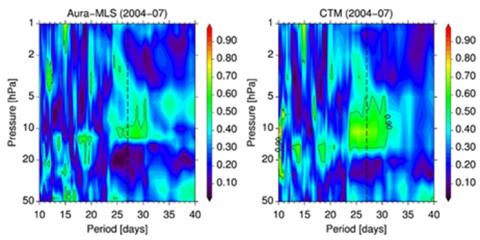[2017] Detecting Sun’s variability in stratospheric ozone
The stratosphere (12-50 km altitude) is sensitive to fluctuations in the incoming solar ultraviolet radiation (UV), which directly modulates stratospheric ozone concentration and temperature. These perturbations induce dynamical changes, which may in turn affect the tropospheric circulation through stratosphere-troposphere couplings. Therefore, an accurate quantification of the impact of the solar UV variability on the composition and thermal structure of the stratosphere is important to understand better the solar-induced Earth’s climate variability.
The solar irradiance has a well-identified variability component associated with the Sun’s rotation (i.e. 27 days) which affects the stratospheric ozone concentration. The observed ozone response to the 27-days cycle was found to be unstable though, varying strongly when different analysis time periods were considered. Furthermore, results from modeling studies which examined the ozone response to 27-day cycles revealed appreciable differences with observational results. To understand better the origin of these discrepancies, we performed a set of model experiments with the chemistry-climate model LMDz-Reprobus that we compared with ozone satellite observations of the UARS MLS and Aura MLS instruments. An example of the ozone response to the 27-day solar cycle in observations and model simulations is displayed on Figure below.
Our analysis first showed that LMDz-Reprobus is able to simulate accurately the observed ozone solar signal. The use of a large ensemble of free-running LMDz-Reprobus simulations however revealed that the internal stratosphere variability contributes to mask the ozone response to the 27-day solar cycle. To reduce this masking effect and better identifying the ozone solar signal, we demonstrated that long time series of analysis are required; typically, 10 years of analysis allows reducing the 1-sigma uncertainty of the ozone solar signal to less than 20%. Hence, the relatively short periods of analysis considered in previous observational studies (less than 3 years) may partly explain the high degree of discrepancies in the retrieval of ozone solar signals at 27-day timescales.
Reference: Thiéblemont R., M. Marchand S. Bekki, S. Bossay, M. Meftah and A. Hauchecorne, Sensitivity of the tropical stratospheric ozone response to the solar rotational cycle in observations and chemistry-climate model simulations, Atmos. Chem. Phys. Discuss., doi:10.5194/acp-2016-1102, 2017
Figure: Coherence between UV solar flux and stratospheric (50-1 hPa) tropical ozone time series (left) measured by Aura MLS and (right) simulated by the model LMDz-Reprobus in its nudged configuration (i.e. dynamics are relaxed toward meteorological reanalysis) over the period 2004-2007. Observation and model results show a consistent and significant ozone response to UV solar flux which appears centered at a period of 27 days and 10 hPa (~30 km).

